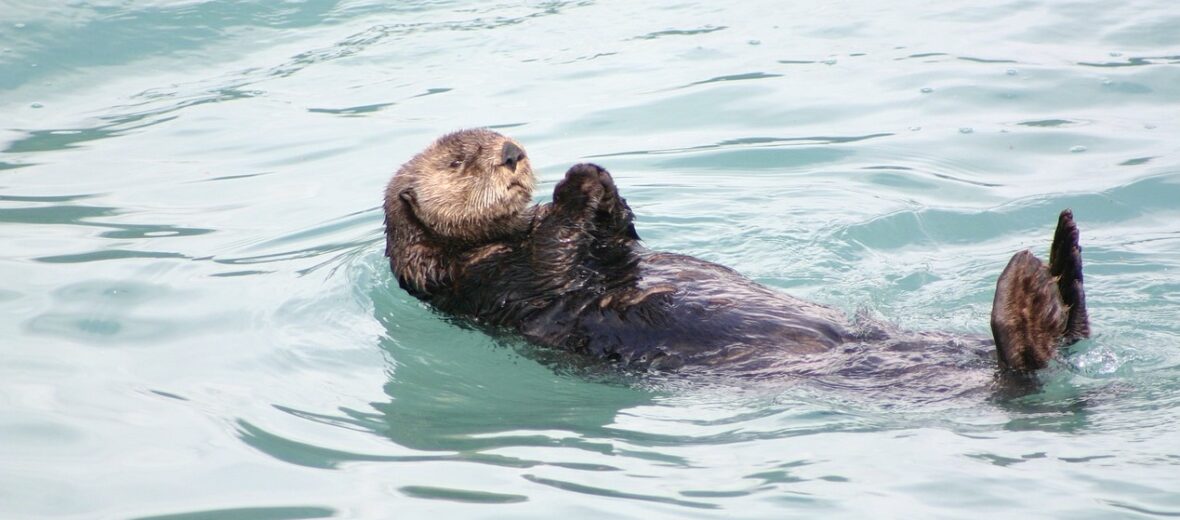
Few critters have tugged the heart strings quite like the sea otter. They float on the surface of the cold ocean water, feet pointing towards the sky, holding hands and juggling rocks. These cute creatures are the smallest sea mammal but the biggest member of the weasel family and, like all weasels, are also crafty and intelligent. As cute as these critters are, they do have a dark side. More on that later. California’s southern sea otter is listed as Endangered by the IUCN.
First the Stats…
Scientific name: Enhydra lutris
Weight: Up to 99 lbs.
Length: Up to 4.9 feet
Lifespan: Up to 20 years
Now on to the Facts!
1.) Their fur is the most dense of any animal on Earth, with an approximated 1 million hairs per square inch! They need this compact arrangement of fur to keep them warm, as they don’t have the blubber needed to keep them warm in the cold ocean water.
2.) These otters are one of the few mammals on the planet to use a tool to help them hunt and feed. They wedge a rock between their chest and armpit and pound their food against it to open it up and provide the tasty meat inside.
3.) The sea otter can live its entire life without ever leaving the water.
4.) They prey on clams, abalones, sea urchins, sea stars, mussels, crabs, snails, squid, and octopuses.
5.) Sea otters are preyed upon by great white sharks.
But wait, there’s more on the sea otter!
6.) These otters eat up to 24 lbs. of food a day! This equals around 25% – 40% of their total weight. They need this amount to sustain their fast metabolisms.
7.) The tooth enamel of a sea otter is much stronger than that of us humans. This helps to prevent their teeth from being chipped when breaking into their prey using their powerful bite force. Their enamel houses additional layers of a protein-rich gel that helps prevent cracks from spreading.
Did you know…?
Male sea otters will sometimes kidnap sea otter pups and hold them underwater until the female gives up her food. This happens so frequently that the term “hostage behavior” has been coined. I told you, they had a dark side.
8.) Skillful as they are, these otters are the only known sea mammal capable of flipping over large rocks in order to look for food.
9.) Oceanic otters can only swim up to 5.5 mph.
10.) These otters can form groups or “rafts” of several dozen individuals. The record was 2,000 sea otters in 1 raft!
But wait, there’s even more on the sea otter!
11.) If a sea otter’s fur gets dirty, it will have trouble absorbing the necessary air to keep it warm. This is why sea otters are totally OCD about keeping their fur clean, and constantly groom themselves day and night; when they’re not eating or sleeping of course.
12.) To keep from drifting apart while they sleep, sea otters will sleep holding each other’s paws. How cute is that?
13.) They are considered a keystone species in their ecosystems because they help control the population of sea urchins which eat and destroy kelp forests.
Did you also know…?
Scientists have witnessed another dark side to sea otters. Some male sea otters have been spotted pursuing, subduing, and trying to mate with other species, like harbor seal pups. They do this aggressively.
14.) Swimming comes so natural to them that they have evolved the ability to hold their breath for up to 8 minutes and dive up to 260 feet.
15.) If you ever see a female otter with a scarred or bloody nose it’s because the male sea otter bites her nose to hold onto her during mating.
But wait, there’s still more on the sea otter!
16.) Sea otters are polygynous (males mate with several females).
17.) Females give birth to a single pup each season.
18.) Sea otters have been reported wrapping themselves and their pups in kelp to keep from drifting out to sea, while they sleep.
Now a Short Sea Otter Video!
Here’s another Short Sea Otter Video!
Also, check out the Critter Science YouTube channel. Videos added frequently!

Want to suggest a critter for me to write about? Let me know here.
Some source material acquired from: Wikipedia & IUCN



